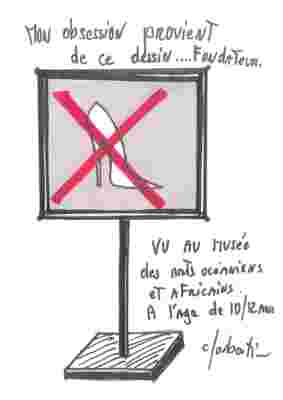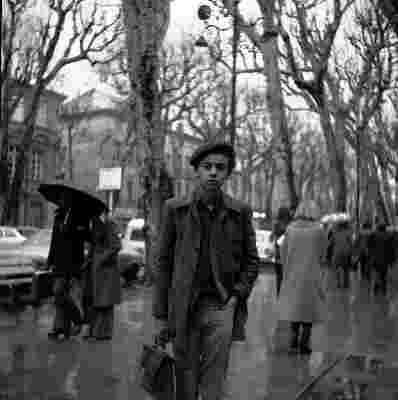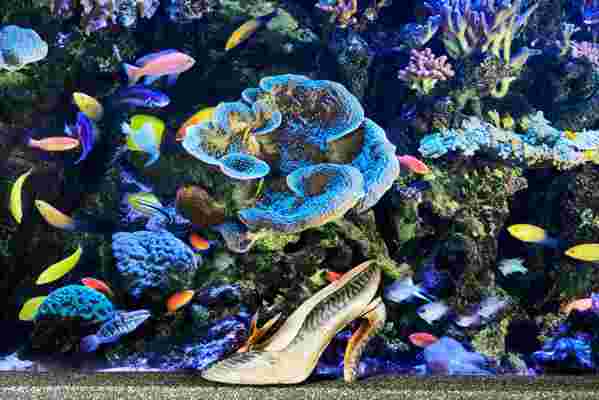When Palais de la Porte Dorée, an Art Deco museum at the edge of Paris's 12th arrondissement, first opened its doors in 1931 for the International Colonial Exposition, its architect, Albert Laprade, installed wooden parquet floors that were particularly susceptible to its visitors’ metal-soled high heels. To protect their delicate nature, the museum displayed an elaborate drawing of a stiletto crossed with an alarming red line, warning women against entering the museum in killer shoes. During one of the many visits he made as a child, having grown up just blocks away, Christian Louboutin was instantly enamored with the sign. Curving from its heel to a pointy front, the silhouette possessed sculptural precision that was accentuated with a subtly sharp arch in the middle, fascinating a teenage Louboutin with its power to seduce and destroy. While it was open for a few short weeks before the COVID-19 pandemic swept Paris and the globe, a replica of the same sign greeted visitors to a Louboutin career survey at that same museum (the exhibition has been postponed until the museum reopens).

A re-creation of the sign he saw as a child, illustrated by Christian Louboutin. The text from top to bottom reads: “My obsession stems from this drawing; seen at the aquarium at the age of 10 or 12.”
“Exhibition(iste)” is an ambitious exhibition highlighting Louboutin’s decades-long career in shoe design and his cultural impact, occupying the second floor of the temporarily closed museum that he considers instrumental in forming his aesthetic vision. The expansive survey puts his work in footwear in conversation with artists and designers he has crossed paths with over the years as collaborators, friends, or sources of inspiration. Commissioned by the designer himself, site-specific works by Imran Qureshi, Lisa Reihana, Whitaker Malem, and Sabyasachi Mukherjee serve as connecting tissues between Louboutin’s visual statements materialized in arresting forms, occasionally in bold red soles.

A young Christian Louboutin, age 14.
“The first time coming to this museum with my older sister, I was not looking for any specific inspiration, but I remember being taken aback by the imposing architecture and the animals inside the aquarium,” Louboutin tells Architectural Digest , referring to the museum’s basement-floor aquarium , which holds 750 species, including a mackerel—the subject of the very first shoe he designed in 1987. Titled Maquereau, the high-heeled shoe humorously replicates the fish, with a striped surface and tail emerging from the front. Louboutin still remembers returning to the museum with the shoe inside his pocket, to photograph his design with limited means in front of the inspirational fish.

The Maquereau shoe created in 1987, in front of the aquarium display.
Geographies, however, have always been a curiosity for the shoemaker, whose glamorous and cutting-edge design has synthesized an unabashed medley of fascinations and discoveries. His continuous experimentation with materials, forms, and colors stems from an aesthete’s thirst for the cultures, environments, and people impacting his hometown of Paris and beyond. “I always question how we give nobility to a piece of art because it has no function, while an object with utility is degraded for having practical purpose,” he explains, as manifested in his urge to push shoemaking to sculptural and even architectural extents.
Royal Strass shoe.
Pigalle shoe.
The Espelio shoe.
A darkened tunnel in the exhibition displays a series of nonwearable shoes in which he challenges function and beauty, rendering the stiletto form as pure sculpture, as well as an object of desire and risk. Their artistic potentials are broadened with a series of photographs by film director David Lynch, who captured models in or next to the shoes, “painted,” according to the designer, with his friend Lynch’s use of artificial light akin to a painter’s use of the brush. With walls covered in “Louboutin red,” the exhibition makes stops at various stages of his boundary-pushing approach to stilettos. Nude pumps created in an inclusive color spectrum applicable to various skin tones are presented inside vitrines in mantra-like arrangements.
Pyrites and the Zuleika shoe.
Exhibited inside a custom-built Bhutanese theater, the LouBhoutan series is dedicated to an impossibly intricate body of work he created with students of the National Institute for Zorig Chusum Thimphu in Bhutan, which he fell in love with after his first visit in 2012. (The series had its New York debut earlier in January with a dramatic staging at Phillips auction house.) The show assures that narrative is crucial for each Louboutin design, the most legendary being his first placement of red soles under a pair of shoes. After working with black or beige soles until 1992, he looked at a factory prototype of a black high-heeled shoe and said, “I’d like to see this without a black presence.” Seeing a model painting her nails red prompted the idea to balance the black with red, a color that is irresistible to anyone no matter how much they like black. “People are drawn to identities, and my red has become a uniting hint of identity,” he says. “It is a pure red that cannot be confused with another color under any shade of light or circumstance.”
An exhibition view.
“Christian Louboutin: Exhibition(iste)” is scheduled to run through July 26, 2020, and is postponed while the museum is closed.
